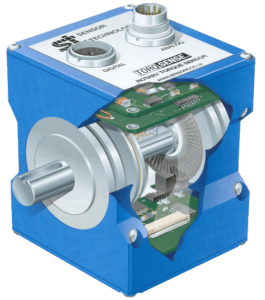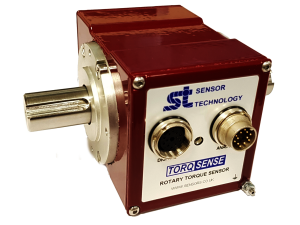Available in other languages:
![]()
![]()
![]()
![]()
![]()
![]()
Sensor Technology is a small hi tech Company involved in the R&D and production of rotary torque measuring transducers using Surface Acoustic Wave (SAW) technology. It is also involved in the licensing of this technology.
The Company is privately owned by the Lonsdale twins, Anthony and Bryan, and Tony Ingham. It has been established for the last 27 years in a picturesque converted water Mill near Banbury, Oxfordshire.
Throughout its history the Company’s skills have been in carrying out bespoke R&D for clients in Magnetometer and Navigation Systems and Torque Sensors. Indeed, it was the amalgamation of working on a navigation and magnetometer system in 1990 that led Anthony Lonsdale to experience problems with the SAW devices he was using and realise that he could turn this disadvantage into an advantage, that SAWs could be used to measure strain.
 The Company has 23 people working in both R&D and production and is ISO 9000 registered.
The Company has 23 people working in both R&D and production and is ISO 9000 registered.
By virtue of its business it has a wide range of customers ranging from Defence, Aerospace, Formula 1 racing teams, universities, testing organisations, discrete parts manufacture and continuous processing.
The Company’s strategy has been to use its Patents associated with SAW technology to concentrate more heavily upon rotary torque sensors in the instrumentation and test markets, e.g. for testing motors, gearboxes and bearings. Up to now the electronics used to interrogate SAWs has been complex and large. The introduction of the new RWT310/RWT320 series uses a different electronics strategy and has been designed for low cost and OEM use. It will offer Sensor Technology a unique advantage by being able to not only to offer a basic transducer that will be welcomed by OEM users but also an advanced transducer that has a number of user configurable features and a variety of outputs. The simplicity, accuracy and cost that the technology has to offer and is now embedded with the new product will, Sensor Technology hopes, benefit many new sectors such as the pump, mixing and motor industries.
SAWs
Acoustic wave devices are not new and have been in commercial use for more than 60 years. In the 1970s, they were developed for pulse compression radar, oscillators and band-pass filters for domestic TV and professional radio. In the 1980s the rise of mobile phones caused a dramatic increase in demand for filters. The telecom industry is the largest consumer, accounting for over 3 billion SAW filters a year and designed to act as band pass filters.
In 1885, the English scientist, Lord Rayleigh predicted such waves to be a major component of earthquakes, a fact to be confirmed much later in the 1920s due to the advent of seismographic recordings.
Some forty-five years later, Voltmer and White, of the University of California, generated such waves, which are more commonly referred to as Surface Acoustic Waves (SAW) or Rayleigh Waves, on the free surface of an isotropic, elastic substrate, namely, quartz.
An important property of a surface acoustic wave is that the Rayleigh wave velocity is approximately 105 times slower than the velocity of electromagnetic radiation in vacuo, and thus, for the same frequency, the wavelength of the elastic wave is less than the wavelength of the corresponding electromagnetic wave by a factor of 105. This result has immediate importance on the geometry of the resulting gauge and is the philosophy behind surface wave technology, since the devices themselves can be much smaller than their electromagnetic counterparts.
A basic SAW device consists of two interdigital transducer arrays (IDTs) on a piezoelectric substrate such as quartz. The IDTs consist of interleaved metal electrodes, readily fabricated using standard integrated circuit technology, which are used to launch and receive the waves, so that an electrical signal is converted to an acoustic wave and then back to an electrical signal. It is this application of an electric field that sets up mechanical stresses and strains. Conversely, if mechanical stress is applied, for example due to strain, an electric field can be generated and hence a signal.
The spacing of the interleaved metal electrodes determines the period of the wave generated. Strain will change the spacing of the interdigital electrodes and hence the resonant frequency. It is this frequency change that Sensor Technology use to measure strain and thus torque.
The operation of a SAW transducer for strain measurement depends on the choice of a suitable piezoelectric substrate, which can be attached to the material to be stressed.
There are many emerging applications for acoustic wave devices. For example torque and tyre pressure sensors for automotive applications, chemical sensors for medical and security applications, and torque, vapour, humidity, temperature, and mass sensors for industrial applications. It is thought that several of these emerging sensor applications may eventually equal the demand of the telecom market.
To apply the SAW element principle to measure torque, two devices are used in a half bridge, analogous to the classic resistive strain gauging configuration; one positioned so as to be sensitive to the principal compressive strain and the other positioned to observe the principal tensile strain.
The two frequencies produced by the SAWs are electronically mixed together to produce the difference and / or sum signals. The difference signal is a measure of induced strain due to the twisting moment and hence, from knowledge of the material properties and the governing equations, the measurement of torque. The sum signal is a measure of shaft temperature.
Coupling of the signals to and from the machine shaft is achieved via an electromagnetic coupling device, separated by a suitable distance, one fixed to the shaft housing and the other fixed to the rotating shaft providing non contact interrogation which is intrinsically safe.
So although it is possible to measure torque using other systems, SAW technology offers a low cost and effective method for measuring torque.
SAW Development
Essentially, torque measurement, using SAW technology consists of three components:
- The SAWs themselves
- A couple
- An electronics package
The Company has developed the Technology over the last 12 years. Over these years it has accumulated a number of patents associated with the Technology and considerable know-how.
New Product
The introduction of the new RWT310/RWT320 offers a compact transducer together with the electronics integrated within the body. It has been possible to achieve this by the development of swept electronic technology, which provides the advantages of a higher bandwidth.
The RWT310 will be offered in a variety of sizes for those who wish to measure torque from 100mNm to 10,000Nm and possible beyond with the option of 4-20mA or 0-20mA current outputs.
The advanced product RWT320 will offer as standard:
- Analog output
- RS232 output
- A high speed USB output
- Built in peak torque sampling, storage and averaging
- A self-diagnostics test package
- The option of a user selectable current output to enable 4-20mA or 0-20mA output





